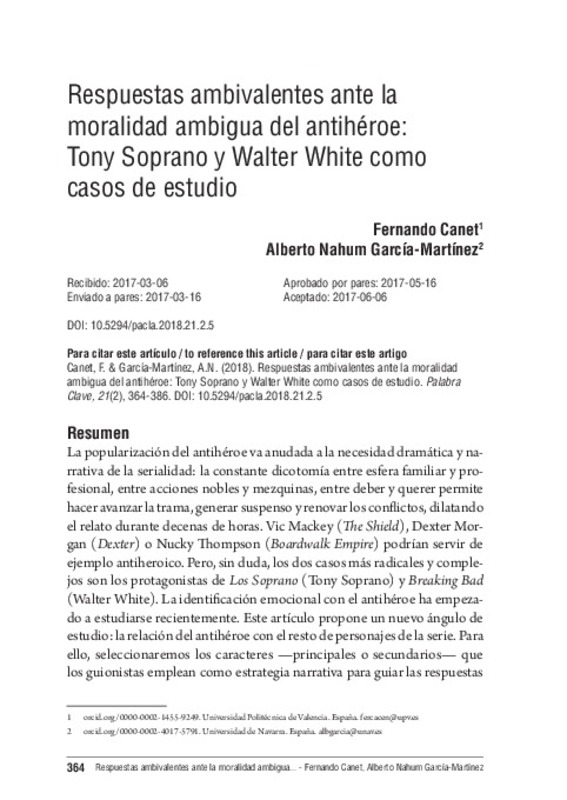|
Resumen:
|
[EN] The popularization of the antihero is linked to the dramatic and narrative need of seriality: the constant dichotomy between the family and professional spheres, between noble and petty actions, between duty and want, ...[+]
[EN] The popularization of the antihero is linked to the dramatic and narrative need of seriality: the constant dichotomy between the family and professional spheres, between noble and petty actions, between duty and want, moves the story forward, generates suspense and renews conflicts, prolonging the story for dozens of hours. Vic Mackey (The Shield), Dexter Morgan (Dexter) or Nucky Thompson (Boardwalk Empire) could serve as an antihero example. However, the two most radical and complex cases are undoubtedly the protagonists of The Sopranos (Tony Soprano) and Breaking Bad (Walter White). The emotional affinity with the antihero has recently become the object of study. This paper proposes a new angle of study: the antihero's relationship with the rest of the characters in the series. For that purpose, we will select the characters - main or secondary - that the writers use as narrative strategy to guide the emotional and moral responses of the spectator the emotional and moral responses of the viewer in their particular relationship with the anti-hero. We will mainly focus on the reactions of these characters to the amoral behaviors of the antiheroes. We propose a methodology of textual analysis that, based on cognitivist theorists, will serve as a mechanism to better understand the construction of the anti-hero and to investigate the effects of authorial decisions on viewers.
[-]
[ES] La popularización del antihéroe va anudada a la necesidad dramática y narrativa de la serialidad: la constante dicotomía entre esfera familiar y profesional, entre acciones nobles y mezquinas, entre deber y querer ...[+]
[ES] La popularización del antihéroe va anudada a la necesidad dramática y narrativa de la serialidad: la constante dicotomía entre esfera familiar y profesional, entre acciones nobles y mezquinas, entre deber y querer permite
hacer avanzar la trama, generar suspenso y renovar los conflictos, dilatando
el relato durante decenas de horas. Vic Mackey (The Shield), Dexter Morgan (Dexter) o Nucky Thompson (Boardwalk Empire) podrían servir de
ejemplo antiheroico. Pero, sin duda, los dos casos más radicales y complejos son los protagonistas de Los Soprano (Tony Soprano) y Breaking Bad
(Walter White). La identificación emocional con el antihéroe ha empezado a estudiarse recientemente. Este artículo propone un nuevo ángulo de
estudio: la relación del antihéroe con el resto de personajes de la serie. Para
ello, seleccionaremos los caracteres ¿principales o secundarios¿ que
los guionistas emplean como estrategia narrativa para guiar las respuestas emocionales y morales del espectador en su particular relación con el antihéroe. Principalmente, nos centraremos en las reacciones que estos personajes exhiben hacia las conductas amorales de los antihéroes. Proponemos
una metodología de análisis textual que, partiendo de teóricos cognitivistas, nos servirá como mecanismo para entender mejor la construcción del
antihéroe e indagar sobre los efectos que las decisiones autorales provocan
en los espectadores
[-]
|









